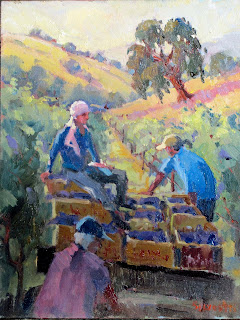
In the painting to the right, I thought how I could make painting easier for myself and would pass this tip to my blogger fans (all 5000 of them). Naturally, in a quick draw we have only 2 hours to complete a painting. I have been doing them so long, they become second nature to me. In other words all paintings are quick draw to a degree. My smaller studies are just that;capturing a mood, feeling, impression of the subject area without too much detail or finish work. On my larger work, that is another thing altogether; I take my time, do detail, finish as needed. Anyway, it dawned on me that an effective painting (like Michele Byrn's award winner of the show) could be one tree, two people and an umbrella. Keeping it simple with just those three items was my goal. Of course, I had other goals like good lighting, color, and drawing the figures ( only three) but in two hours, how much can I get done? So I went at it.
The three umbrellas above are the outcome. I am fairly pleased with this because I kept all the mid background colors neutral, allowing the figures and light in the tree to pop. Tip? When you want an object to jump out and draw attention, keep all adjacent color notes back or in shades of grey. The highly colored areas will, therefore, come forward or 'pop' as we artists like to say. BYW the mid area is where you want all action and best color to appear.
Handling the light was critical as well. I designed the light to cascade from left to right, down in a strong direction, splashing on the figures who by the way I had to coax to sit for me and model with a cup of coffee. Turned out a nice family dropped in willing to assist me in this project--they were perfect. Hubby didn't want to do it but his wife was the mother of two child models so she was sympathetic to my cause. Anyway, my thoughts are strong light, good color, two or three main objects. Of course I managed to make it more complex, in spite of this goal and added bright lite trees and a few other odd ends but I kept it to a small roar. It sold, happily to a lady who loved it at the auction, always caping a happy end to this adventure but we had lots of fun throughout this event. If you have't ever attended one, you should go. If you enter one, try keeping it simple--two or three objects done really well is enough, good light and stong color coupled with neutrals. You will do well! On the second thought, these tips may apply to all painting now that I think of it. Humans tend to over muck things and make them complex--the viewer feels this complexity and it is turned off. I just left the palm springs art museum who had an Edgar Payne painting--very simple. A large cliff in light, small shadowed cliff and three native americans. Yet the painting was excellent!! Most of the great art historically are very simple--one person smilling, two sailboats, etc.
Lastly, have a goal for yourself on every paint outing. I set out to do good greys or neutrals, unusual composition, or great color. This will help push yourself to improve--have a painting buddy where you can get critique from, send your images to teachers who offer that service (like me for a small donation). Go to a museum and study the masters asking yourself how did they mix that, what was they composition, can I do that? Well, share with me if these things help. I would love to hear from you.















